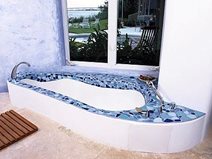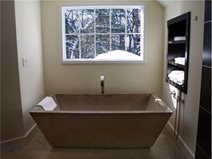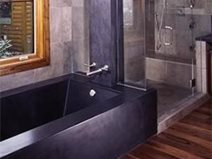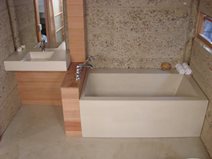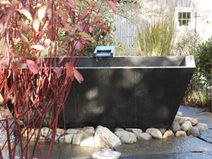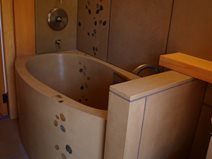- Staining Concrete
- Stamped Concrete
- Concrete Overlays
- Concrete Resurfacing
- Concrete Polishing
- Concrete Dyes
- Colored Concrete
- Indoor Concrete
- Concrete Floors
- Concrete Countertops
- Garage Floor Coatings
- Furniture, Sinks, Fire Bowls
- Basement Floors
- Outdoor Concrete
- Concrete Patios
- Concrete Driveways
- Concrete Pool Decks
- Outdoor Kitchens & Counters
- Outdoor Fireplace
- Concrete Walkways
- Concrete Pavers
- Concrete Walls
- Repair & Maintenance
- Foundation Repair
- Concrete Crack Repair
- Concrete Sealers
- Building with Concrete
- Concrete Homes
- Concrete Basements
- Decorative Concrete
- Fire Resistant
Six Great Design Ideas for Concrete Tubs
See the creative ways homeowners are using concrete tubs and tub surrounds to give their bathrooms distinction By Anne Balogh, ConcreteNetwork.com columnistIf you want a bathtub that's unique, personalized, looks natural, and has lots of character, then concrete is the perfect alternative. What's more, concrete tubs are available in colors and shapes not possible with factory-made tubs, and you can size the tub to fit any existing bathroom space, large or small. From a maintenance standpoint, concrete tubs offer additional advantages. When properly sealed, they are water- and stain-proof, and the color will never fade or chip away.
Here are six ideas for using concrete tubs to make a big splash in your bathroom or outdoor spa design plans.
1. Go with an unusual shape
Make your concrete tub the focal point of the room by casting it in a distinctive shape. Just about anything is possible, including oval, square, round and curvilinear styles. This one-piece concrete tub for a remodeled master bathroom suite slopes inward on all sides, like a flat-bottomed boat. It's prominently displayed right beneath the bathroom window (through which it made its entry) and is installed on a plinth, creating a shadow at the base that makes the tub appear to be floating.
2. Pick a rich color scheme
With a concrete tub, you're not stuck with bland shades of white or almond. You can choose richer, earthier tones that give your room warmth and elegance. Many concrete tub owners like to use shades of brown, tan, and even charcoal to enrich their space.
3. Make it large enough for two
You can make a concrete tub nearly any size, so why not make it roomy enough for sharing? (As a bonus, you'll also conserve water.) This monolithic soaking tub in a remodeled master bathroom is 72 inches long and 36 inches wide, providing ample room for two. Tip: Just be sure you can fit the tub into your space, and the floor framing can bear the weight.
4. Consider a concrete tub surround
If the weight or size of a precast concrete tub is an issue, or you simply want to dress up an existing tub, you can surround a standard tub with concrete panels. Here's a concrete tub surround that was cast in three pieces to make transportation and installation easier. The teal color matches the concrete vanity and integral sinks.
5. Create an outdoor oasis
Because concrete is weather resistant, you can also put your tub outdoors. You can even cast radiant heating coils in the tub walls to warm the water. This outdoor soaking tub also uses water heated by a solar system installed on the roof of the home. Another advantage of an outdoor tub: You can make it as large as you want without worrying about the extra weight.
6. Replicate a Korean bathhouse
A deep tub, used for not only bathing but also for relaxation, is customary in Korean culture. This custom project replicates a Korean bathhouse and includes an Asian soaking tub, concrete wall and floor tiles, and a concrete sink. Adding to the authenticity of the project was the input of consultants flown in from Korea to help with the design.
